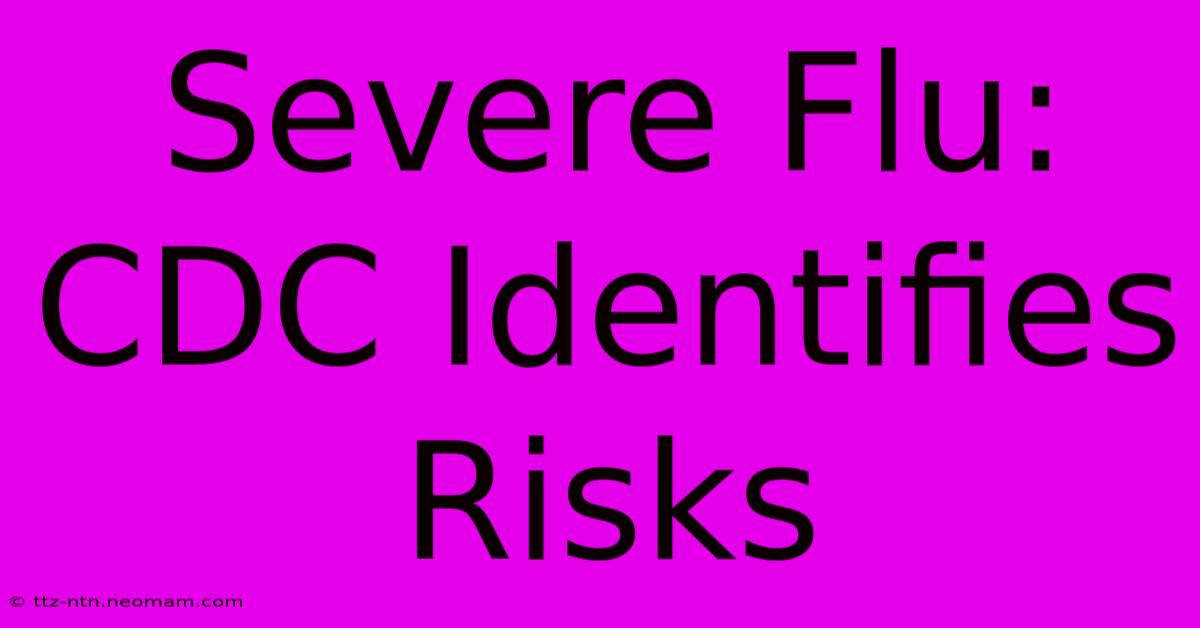Severe Flu: CDC Identifies Risks

Discover more detailed and exciting information on our website. Click the link below to start your adventure: Visit Best Website. Don't miss out!
Table of Contents
Severe Flu: Unmasking the CDC's Risk Factors
Is severe influenza a looming threat? The CDC's identification of key risk factors provides crucial insights into preventing serious illness and complications. Editor's Note: This comprehensive guide on severe influenza and associated risks, based on CDC data, was published today. Understanding these risks is paramount for safeguarding public health.
Why is this important? Severe influenza can lead to hospitalization, long-term health issues, and even death. This article summarizes the CDC's findings on risk factors, offering crucial information for individuals and communities to mitigate the impact of this potentially deadly disease. The review includes semantic and LSI keywords related to influenza severity, risk factors, and preventative measures.
Analysis: This article synthesizes information from the CDC's publications, scientific literature, and expert opinions to create a comprehensive guide for understanding and mitigating the risk of severe influenza. Significant effort was dedicated to organizing the data in an accessible and informative manner, thereby assisting readers in making informed decisions regarding their health.
| Key Risk Factors for Severe Influenza | Description |
|---|---|
| Age (65+) | Advanced age weakens the immune system, increasing susceptibility. |
| Underlying Medical Conditions | Chronic diseases like heart disease, lung disease, diabetes, and kidney disease significantly increase risk. |
| Pregnancy | Changes in the immune and respiratory systems during pregnancy elevate vulnerability. |
| Immunocompromised Individuals | Weakened immune systems due to medical conditions or treatments hinder effective defense against the virus. |
| Obesity | Excess body fat negatively impacts immune function and respiratory capacity. |
| Nursing Home Residents | Close-quarters living increases transmission risk, coupled with often-weakened immune systems. |
Severe Flu: Understanding the Risks
Introduction: This section highlights the key risk factors identified by the CDC, emphasizing their significant impact on influenza severity.
Key Aspects: Age, underlying health conditions, pregnancy, immunocompromise, obesity, and living conditions (e.g., nursing homes) are crucial factors increasing severe influenza risk.
Discussion:
Age and Severe Influenza
Introduction: Advanced age is a major risk factor for severe influenza, largely due to age-related decline in immune function.
Facets:
- Role of Age: The aging immune system's decreased ability to respond effectively to viral infection.
- Examples: Higher hospitalization and mortality rates among older adults.
- Risks and Mitigations: Increased susceptibility to complications; annual influenza vaccination is crucial.
- Impacts and Implications: Strain on healthcare systems, increased mortality rates.
Summary: The link between age and severe influenza is undeniable, underlining the importance of vaccination and preventative measures for older populations.
Underlying Health Conditions and Severe Influenza
Introduction: Pre-existing medical conditions significantly increase the risk of severe influenza complications.
Further Analysis: Conditions like heart, lung, kidney, and liver diseases, along with diabetes and weakened immune systems, exacerbate the effects of influenza infection, often leading to secondary infections or complications.
Closing: Effective management of chronic conditions, coupled with influenza vaccination, helps mitigate this risk.
Information Table:
| Underlying Condition | Increased Risk of: | Mitigation Strategies |
|---|---|---|
| Heart Disease | Myocarditis, cardiac arrhythmias | Careful monitoring, prompt medical attention |
| Lung Disease | Pneumonia, respiratory failure | Vaccination, pulmonary rehabilitation |
| Diabetes | Increased susceptibility to infection | Strict blood sugar control |
| Kidney Disease | Impaired immune response | Close medical supervision |
FAQ
Introduction: This section addresses common questions regarding severe influenza and its associated risk factors.
Questions:
- Q: Who is most at risk of severe influenza? A: Individuals 65 and older, those with underlying health conditions, pregnant women, immunocompromised individuals, and residents of nursing homes.
- Q: What are the common complications of severe influenza? A: Pneumonia, bronchitis, ear infections, sinus infections, and worsening of underlying health conditions.
- Q: How can I reduce my risk of severe influenza? A: Annual influenza vaccination, practicing good hygiene (frequent handwashing), and avoiding close contact with sick individuals.
Summary: Understanding risk factors is crucial for preventative measures.
Transition: Proactive steps significantly reduce severe influenza's impact.
Tips for Preventing Severe Flu
Introduction: This section provides practical advice for mitigating the risk of severe influenza.
Tips:
- Get Vaccinated: Annual flu shots are highly effective in reducing the risk of severe illness.
- Practice Good Hygiene: Wash hands frequently and thoroughly.
- Avoid Close Contact: Stay away from sick individuals whenever possible.
- Stay Home When Sick: Prevent the spread of the virus.
- Healthy Lifestyle: Maintain a healthy diet and sufficient rest.
- Consult Your Doctor: Discuss vaccination and preventive measures with your healthcare provider, especially if you have underlying health conditions.
Summary: Proactive prevention minimizes severe influenza risks.
Summary of Severe Influenza Risks
Summary: The CDC's identification of high-risk groups for severe influenza highlights the importance of vaccination, preventative measures, and proactive healthcare strategies.
Closing Message: Understanding and addressing these risk factors are essential for safeguarding public health and reducing the burden of severe influenza. Continuous vigilance and adherence to public health recommendations remain crucial in combating this ongoing health challenge.

Thank you for visiting our website wich cover about Severe Flu: CDC Identifies Risks. We hope the information provided has been useful to you. Feel free to contact us if you have any questions or need further assistance. See you next time and dont miss to bookmark.
Featured Posts
-
Drivers Of Food Safety Testing Market
Nov 26, 2024
-
L Emission Colere Dans Le Pre Et Ses Soutiens
Nov 26, 2024
-
Ispolzuyte Sotsialnye Seti Prodvigayte Statyu V Sotsialnykh Setyakh
Nov 26, 2024
-
Great Valley Invests In Tjx Companies
Nov 26, 2024
-
Resultados Ameri Cup 2025 Segundo Dia
Nov 26, 2024
